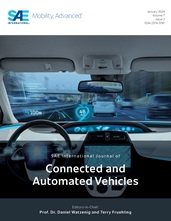Validating Human Factors-Based Classification Models for Safe and Efficient Mixed-Autonomy Interactions at Intersections Using a Virtual Simulator
- Features
- Content
- The introduction of autonomous vehicles (AVs) promises significant improvements to road safety and traffic congestion. However, mixed-autonomy traffic remains a major challenge as AVs are ill-suited to cooperate with human drivers in complex scenarios like intersection navigation. Specifically, human drivers use social cooperation and cues to navigate intersections while AVs rely on conservative driving behaviors that can lead to rear-end collisions, frustration from other road users, and inefficient travel. Using a virtual driving simulator, this study investigates the use of a human factors-informed cooperation model to reduce AV reliance on conservative driving behaviors. Four intersection scenarios, each involving a left-turning AV and a human driver proceeding straight, were designed to obfuscate the right-of-way. The classification models were trained to predict the future priority-taking behavior of the human driver. Results indicate that AVs employing the human factors-informed model were able to navigate the mixed-autonomy intersection scenarios significantly more efficiently without affecting safety or rider comfort when compared to a baseline, cautious AV. Overall, this research contributes to improved mixed-autonomy interactions and provides evidence for the importance of cooperation between AVs and human-driven vehicles.
- Pages
- 13
- Citation
- Ziraldo, E., and Oliver, M., "Validating Human Factors-Based Classification Models for Safe and Efficient Mixed-Autonomy Interactions at Intersections Using a Virtual Simulator," SAE Int. J. CAV 8(2), 2025, https://doi.org/10.4271/12-08-02-0019.
